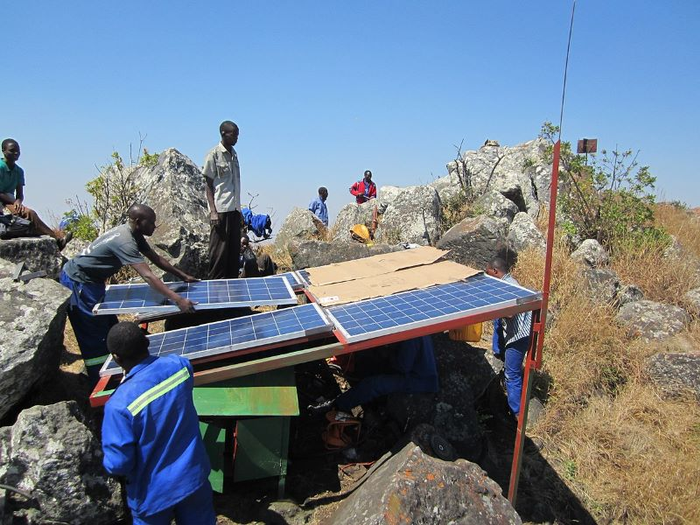An example of using AI tools to farm. Image by Freepik
Before we start talking about all things “AI” let us provide you with some stats that will solidify the reason behind this blog:
- According to AI4D Africa, Africa accounts for only 2.5% of the worldwide Artificial Intelligence (AI) industry, but developing applications might increase the continent’s GDP by $2.9 trillion by 2030.
- According to GSMA, the bulk of the Africa AI use case applications found are connected to agriculture (49%), climate action (26%), and energy (24%).
Africa is often described as a land of untapped potential, but now it’s entering into the technological revolution that could shape its future—the use of artificial intelligence (AI). Only a small fraction of the global AI market is currently housed in Africa. That potential is enormous, but this isn’t about AI for innovation’s sake; it’s about adding concrete, lasting value across foundational areas in agriculture, energy, and climate action. This blog will go deeper into the fresh opportunities that Africa opens up through AI, derive socio-economic growth, and unlock hitherto unimaginable opportunities.
AI in Agriculture: Sowing the Seeds of Prosperity
Agriculture has always played a central part in African life, providing work for nearly 60 percent of the African population and accounting for a significant share of the continent’s GDP. Yet despite agriculture’s crucial role, many African farmers continue to use outdated methods for many, fighting against unpredictable weather, poor soils, and a lack of access to basic information.
Here is the area for which AI meets in bridging the traditional farming practice gap with modern data-driven agriculture. The best and most impactful use of AI is through ML-powered advisory platforms: Everything about real-time to farmers in terms of soil health, weather forecasts, and many more to make smarter and more sustainable decisions.
For instance, consider a subsistence maize farmer in Kenya. Traditionally farmers would plant through local knowledge and intuition. Today, AI-driven digital tools accessible on basic smartphones can make a difference by providing tailored advice on optimal planting times, water use, and crop rotation strategies. AI makes agriculture more effective by having a mass of considerations such as the type of soil, weather during previous seasons, and even market demand to alter farming patterns.
What is beautiful about AI in agriculture, however, is its scalability. The effects are already visible: increased yields, fewer resources being wasted, and more resilience to the ever-growing threat of climate change. And it’s not only the farmer who benefits; the effects cascade through entire communities when food security improves and incomes increase.

Maize farm in Africa. Steve Kally, CC BY-SA 4.0, via Wikimedia Commons
Energy: Illuminating Africa’s Future with AI
Africa still holds a large portion of the population of one of the most challenging continents to access reasonable energy supplies, with almost half of its population still in darkness without power. Energy poverty causes more obstruction to everyday life as it strikes economic growth since it hinders people’s access to education and businesses from succeeding. However, AI has altered this scenario.
Predictive maintenance of energy grids by AI is one of the promising applications in the energy sector. Power outages, through large parts of Africa due to the breakdowns of infrastructures, are a big problem. AI will be able to monitor the energy grids in real-time and detect weak points, allowing it to predict where failures are likely to happen, thus not only lowering the risk of power outages but also cutting the cost for the companies generating energy, which can be used to increase their services.
AI is also empowering the optimization of renewable energy solutions such as solar and wind for off-grid locations. With analysis of weather data and patterns in energy consumption, AI ensures systems for renewable energy are deployed in places where the systems are needed the most and prove to be most effective in generating electricity to remote communities while enabling broader digital connectivity, and access to AI-based services in agriculture and education.
In addition, AI makes energy more accessible by enabling financing models that are productive for the use of energy. For example, it is possible to roll out microfinancing solutions to help people or small business units invest in renewable energy technologies, such as solar panels. Using repayment capacity and usage patterns, AI models can ensure that financing options are not only affordable but sustainable, as well, opening up energy access even to the most distant points on the African continent.

Mounting solar panels. Source: JonStrand, CC BY-SA 4.0, via Wikimedia Commons
Climate Action: AI at the Frontlines of a Global Crisis
Africa is, indeed, at the epicenter of the climatic crisis, where the effects of extreme weather events – floods, and droughts, are killing and destroying, yet still, AI presents a powerful tool in mitigating these challenges.
One of the key applications of AI in climate action is in Early Warning Systems that predict natural disasters. Machine learning models analyze big data sets coming from satellite imagery and remote sensors to predict everything from droughts to floods. For example, AI-powered systems already predict drought conditions in East Africa months before governments and farmers can take crucial measures before the worst effects kick in.
These warnings can be lifesavers. They enable the community to amass resources, shift livestock to safer areas, or even adopt water-saving measures. More important is that such systems, while addressing the immediate risk, provide insights over the long term, which may be used to inform policy and resource allocation and thereby help countries better withstand future disasters.
But beyond the use of AI for predicting disasters, there are applications of this technology in biodiversity monitoring and natural resource management. Some of the world’s most significant ecosystems are found in Africa, from the Congo Basin to the Serengeti. However, these are all threatened by deforestation, poaching, and industrial expansion. AI tools, camera traps, and drones assist conservationists in monitoring wildlife population densities, tracking illegal activities, and continually monitoring the overall health of the ecosystem. The data collected is crucial for strategies that protect Africa’s Rich biodiversity while balancing the needs of growing populations.

Flooding in Ghana. Source: Fquasie, CC BY-SA 4.0, via Wikimedia Commons
Tackling the Roadblocks to AI Adoption
While the potential for AI revolutionizing Africa is immense, the journey is not without its hurdles. One of the biggest hurdles has to do with the data; big data means that these models need such mind-boggling amounts of data to work properly, which needs localizing to account for unique African market conditions. Sadly, there is a pretty fair deficit in terms of the availability of high-quality, locally relevant data, especially in local languages.
Another kind of challenge is the infrastructure gap. AI requires computing power and Africa lacks a form of data centers and high-powered hardware such as Graphics Processing Units, or in simpler terms, GPUs. The issue of GPUs is cost-prohibitive in South Africa and Kenya, and so the scale in large-scale AI projects becomes pretty problematic.
But here is a possible way around this problem: mobile-first AI solutions. With the increasing rate of usage of smartphones, applications of AI can be designed to run on mobile phones instead of expensive, centralized computing infrastructure. Much promise has been held for edge computing, processing data directly on devices like phones and laptops making AI more accessible and scalable because it does not rely as much on massive data centers.
Building a Future Powered by AI
AI will change the socio-economic face of Africa; in agriculture and many other sectors, it is more about energy and climate resilience. Already, AI is beginning to deliver on its promise-from increasing crop yields and expanding access to energy to protecting the environment and saving lives.
Thus, the only way through which Africa can fully realize the capability of AI is through collaboration among governments, private firms, and civil society organizations with investments in infrastructure, data, and digital skills that drive AI development. With this in mind, Africa may truly unlock AI capability and even take the lead in harnessing technology for sustainable growth that is inclusive of all.
The African AI revolution is still in its infancy, but it’s already changing the continent’s future. The right strategies and investments will certainly brighten up that future AI can open a new door to prosperity on the continent.

Anand Subramanian is a freelance photographer and content writer based out of Tamil Nadu, India. Having a background in Engineering always made him curious about life on the other side of the spectrum. He leapt forward towards the Photography life and never looked back. Specializing in Documentary and Portrait photography gave him an up-close and personal view into the complexities of human beings and those experiences helped him branch out from visual to words. Today he is mentoring passionate photographers and writing about the different dimensions of the art world.





